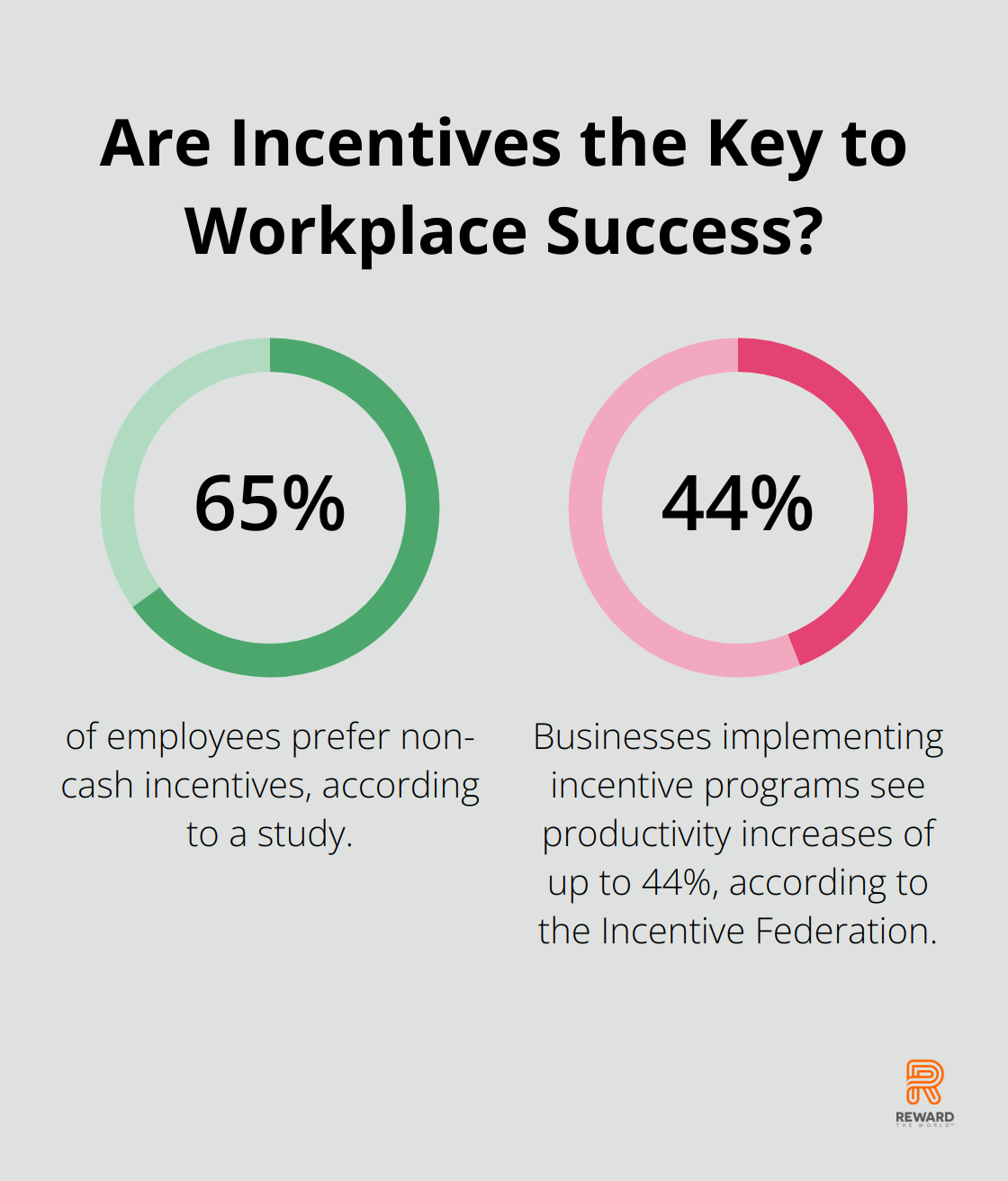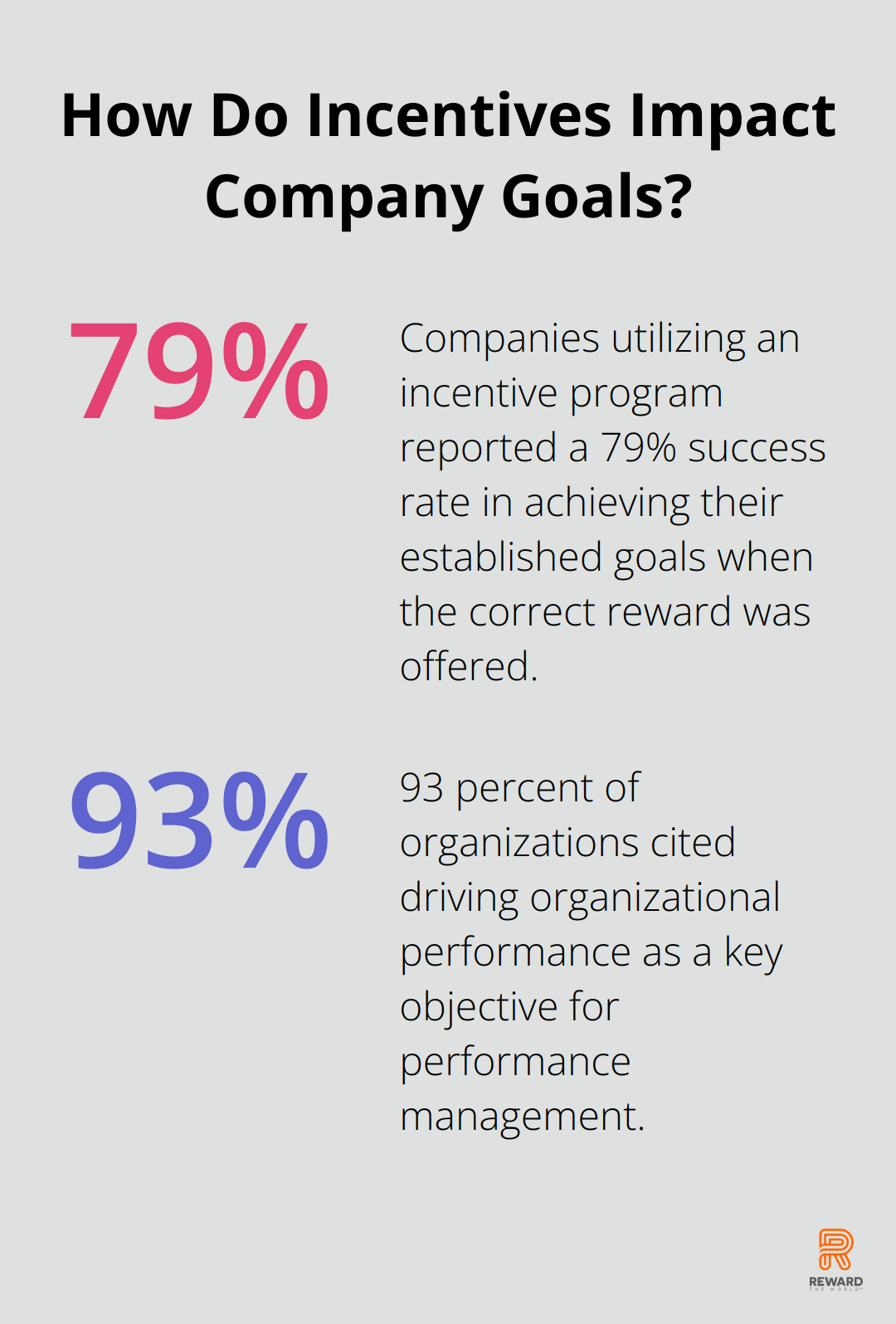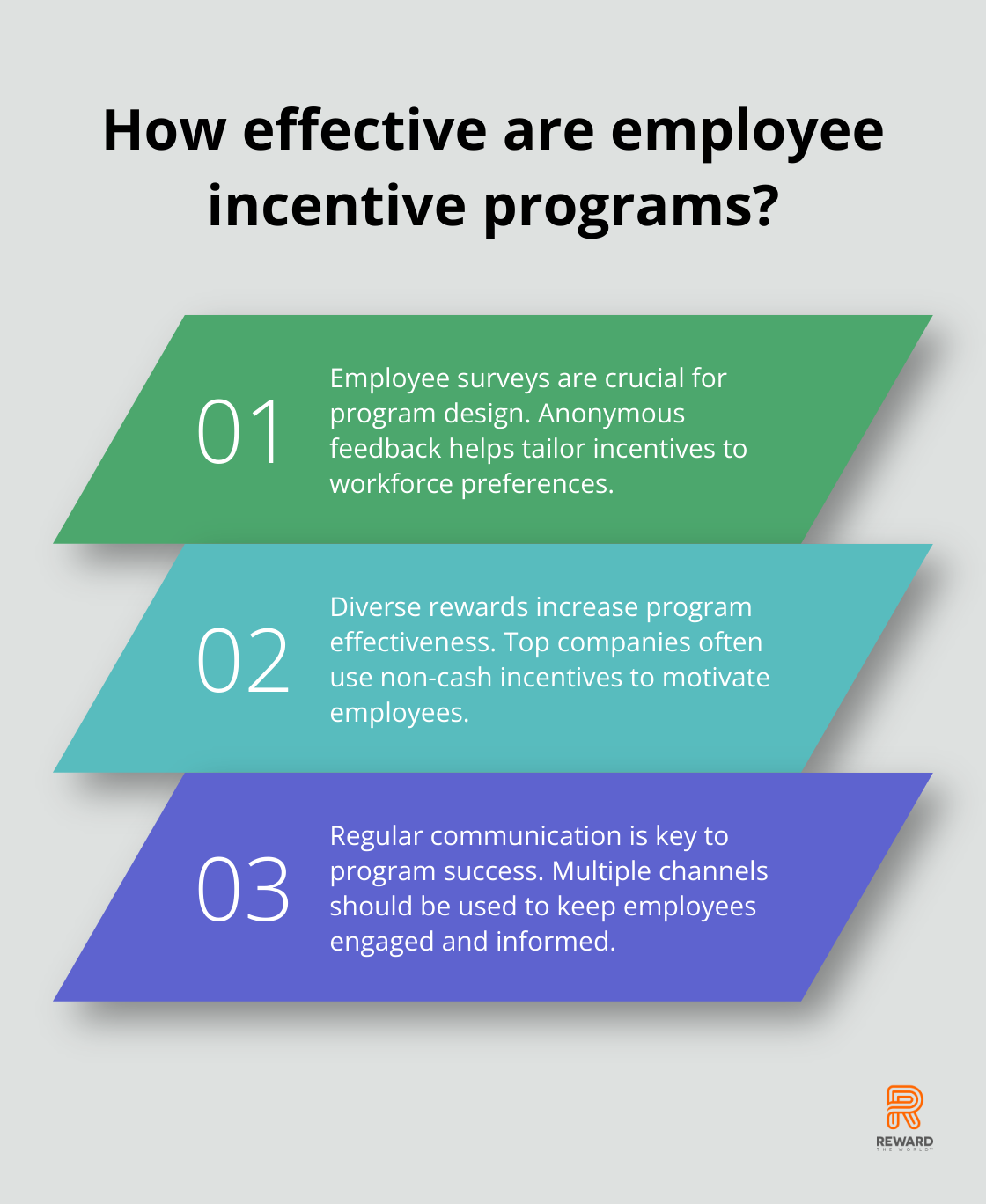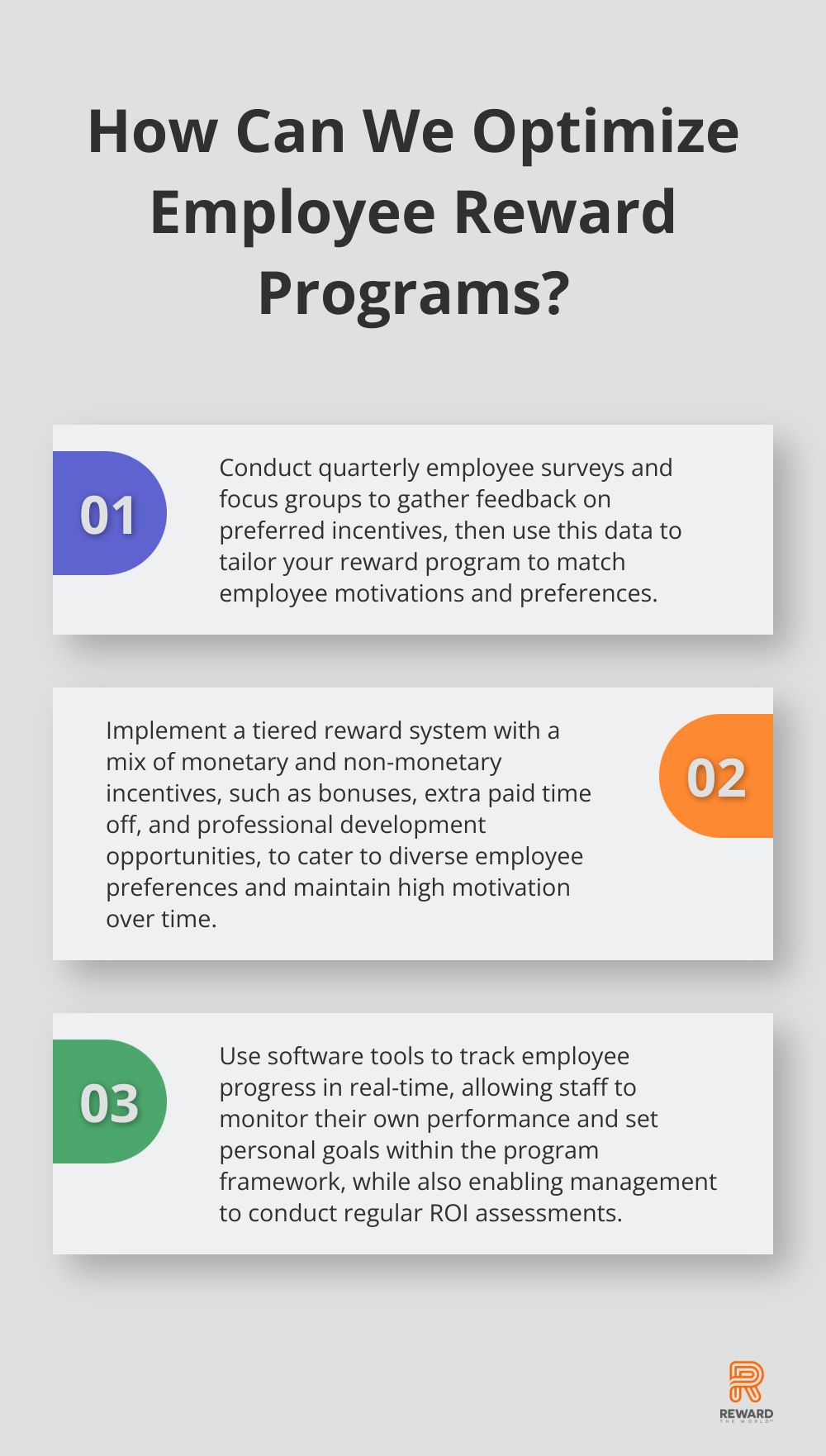
Employee incentive reward programs are powerful tools for boosting productivity and morale in the workplace. At Reward the World, we’ve seen firsthand how well-designed programs can transform company culture and drive results.
But creating an effective incentive program isn’t as simple as handing out bonuses. It requires careful planning, implementation, and ongoing management to truly make an impact.
What Are Employee Incentive Programs?
Definition and Purpose
Employee incentive programs serve as strategic tools to motivate and reward staff for their performance and contributions. These programs aim to align employee behavior with company goals, fostering a culture of high performance and engagement.
Types of Incentives
Incentives come in various forms, catering to different employee preferences and organizational objectives:
- Monetary Incentives:
- Bonuses
- Profit-sharing
- Commission structures (e.g., sales teams receiving a percentage of their total sales)
- Non-monetary Incentives:
- Extra paid time off
- Flexible working hours
- Professional development opportunities
- Public recognition
A study found that 65% of employees prefer non-cash incentives, highlighting the importance of a diverse reward strategy.
Measurable Benefits
The impact of well-designed incentive programs proves significant and quantifiable:
- Companies that invest in successful employee recognition programs have a higher retention rate and a more engaged and productive team
- Businesses implementing incentive programs see productivity increases of up to 44% (Incentive Federation)
- Employees who feel adequately recognized are 5 times more likely to feel connected to their company culture (Gallup survey)

For employees, these programs offer more than just financial gains. They provide a sense of accomplishment, improve job satisfaction, and create opportunities for career growth.
Tailoring Programs for Success
The most effective programs adapt to the specific needs and preferences of the workforce. This might include offering a mix of immediate rewards (like spot bonuses) and long-term incentives (such as stock options) to cater to different employee motivations.
Regular assessment and adjustment of these programs prove essential. Employee preferences change over time, and what motivates one generation might not work for another. Conducting regular surveys and feedback sessions helps keep incentive programs relevant and effective.
The Role of Technology
Modern incentive programs leverage technology for seamless implementation and tracking. Platforms (like Reward the World) offer robust analytics, allowing companies to measure the ROI of their incentive programs accurately. This data-driven approach enables businesses to refine their strategies continually, ensuring maximum impact and employee satisfaction.
As we move forward, let’s explore the key elements that make these incentive programs truly successful and impactful for both employees and employers.
What Makes Incentive Programs Effective?
Set Clear, Measurable Goals
The foundation of any effective incentive program lies in its objectives. These goals should be specific, measurable, achievable, relevant, and time-bound (SMART). For instance, instead of a vague goal like “increase sales,” companies should opt for “boost quarterly sales by 15% within the next six months.”
Companies utilizing an incentive program reported a 79% success rate in achieving their established goals when the correct reward was offered. This high success rate underscores the importance of clarity and appropriate rewards from the outset.
Personalize Rewards
One size doesn’t fit all when it comes to incentives. More than 9 in 10 (93 percent) cited driving organizational performance as a key objective for performance management, yet less than half (44 percent) are achieving this goal. This discrepancy highlights the importance of personalizing rewards to effectively drive performance.

Companies should consider offering a range of rewards:
- Financial incentives (bonuses, profit-sharing)
- Professional development opportunities (training courses, conference attendance)
- Work-life balance perks (extra vacation days, flexible hours)
- Experiential rewards (team outings, tickets to events)
Ensure Fairness and Transparency
Transparency builds trust. Companies should clearly communicate how employees can earn rewards and how their performance is measured. This openness prevents misunderstandings and fosters a sense of fairness.
Implementing a points-based system where employees can track their progress in real-time proves effective. This visibility motivates continued engagement and allows staff to set personal goals within the program framework.
Continuously Evaluate and Adjust
The most successful incentive programs evolve. Companies should regularly assess the program’s effectiveness through:
- Employee surveys (try to collect feedback at least quarterly)
- Performance metrics analysis (track KPIs before and after implementation)
- Participation rates (low engagement might signal a need for adjustments)
Leverage Technology
Modern incentive programs benefit from technological advancements. Platforms like Reward the World offer robust analytics, allowing companies to measure the ROI of their incentive programs accurately. This data-driven approach enables businesses to refine their strategies continually, ensuring maximum impact and employee satisfaction.
As we move forward, let’s explore how companies can implement these key elements to create impactful incentive programs that drive results and boost employee engagement.
How to Implement an Effective Employee Incentive Program
Conduct a Comprehensive Needs Assessment
Before you design your program, perform a thorough assessment of your company culture and employee needs. This step will help you tailor incentives that resonate with your workforce:
- Survey your employees: Use anonymous surveys to collect honest feedback about what motivates them. Ask about preferred rewards, current pain points, and areas where they feel undervalued.
- Analyze performance data: Review existing performance metrics to identify areas that need improvement. This data will help you set realistic goals for your incentive program.
- Organize focus groups: Set up small group discussions with employees from different departments to gain deeper insights into their motivations and preferences.
- Research industry benchmarks: Investigate what similar companies in your industry offer to ensure your program remains competitive.
Create a Flexible Program Structure
With insights from your assessment, develop a program structure that motivates and achieves results. Consider these key elements:
- Set specific, measurable goals: Define clear objectives that align with your company’s overall strategy (e.g., “Increase customer satisfaction scores by 15% within six months”).
- Offer diverse rewards: Include a mix of monetary and non-monetary incentives. Top-performing companies often provide non-cash rewards to great effect.
- Implement tiered rewards: Create a system where employees earn increasingly valuable rewards as they hit higher performance targets. This approach maintains high motivation over time.
- Balance individual and team-based incentives: This combination promotes personal achievement while encouraging collaboration.
Communicate Clearly and Frequently
Effective communication is essential for program success. Use these strategies to ensure your employees understand and engage with the incentive program:
- Launch with excitement: Host a company-wide meeting or event to introduce the program. Make it memorable and engaging.
- Provide detailed documentation: Create a comprehensive guide that outlines program rules, goals, and rewards. Ensure easy access for all employees.
- Use multiple channels: Utilize email, intranet, team meetings, and physical posters to keep the program at the forefront of employees’ minds.
- Highlight success stories: Regularly showcase employees who have earned rewards. This recognition not only celebrates their achievements but also inspires others.
Monitor, Measure, and Refine
Continuous evaluation ensures long-term success. Follow these steps to effectively monitor and improve your program:
- Use robust tracking tools: Employ software that allows real-time tracking of employee progress. Platforms like Reward the World offer comprehensive analytics for this purpose.
- Schedule regular reviews: Conduct quarterly assessments of program performance. Examine participation rates, goal achievement, and overall impact on company KPIs.
- Collect ongoing feedback: Use pulse surveys to gather employee opinions about the program. Ask if they find it motivating and if the rewards are meaningful.
- Remain flexible: If certain aspects of the program don’t work, make changes promptly. Adaptability is key to maintaining engagement.
- Calculate ROI: Determine the return on investment by comparing program costs against improvements in key metrics like productivity, sales, or employee retention.

Final Thoughts
Employee incentive reward programs transform workplace dynamics, boost productivity, and enhance employee satisfaction. These programs align individual efforts with organizational goals when designed and implemented effectively. Understanding your workforce, setting clear objectives, and offering diverse rewards that cater to different preferences form the foundation of impactful incentive programs.

Regular evaluation and adjustment ensure that programs remain relevant and continue to motivate employees over time. Companies can maximize the impact of their incentive initiatives through careful planning, clear communication, and ongoing management. The most successful programs adapt to changing employee needs, industry trends, and organizational objectives.
We at Reward the World offer a comprehensive solution for creating and managing effective employee incentive reward programs. Our platform provides businesses with tools to implement, track, and optimize their incentive programs (with global reach and diverse reward options). Take action now to invest in your employees and see returns in productivity, loyalty, and overall company success.
